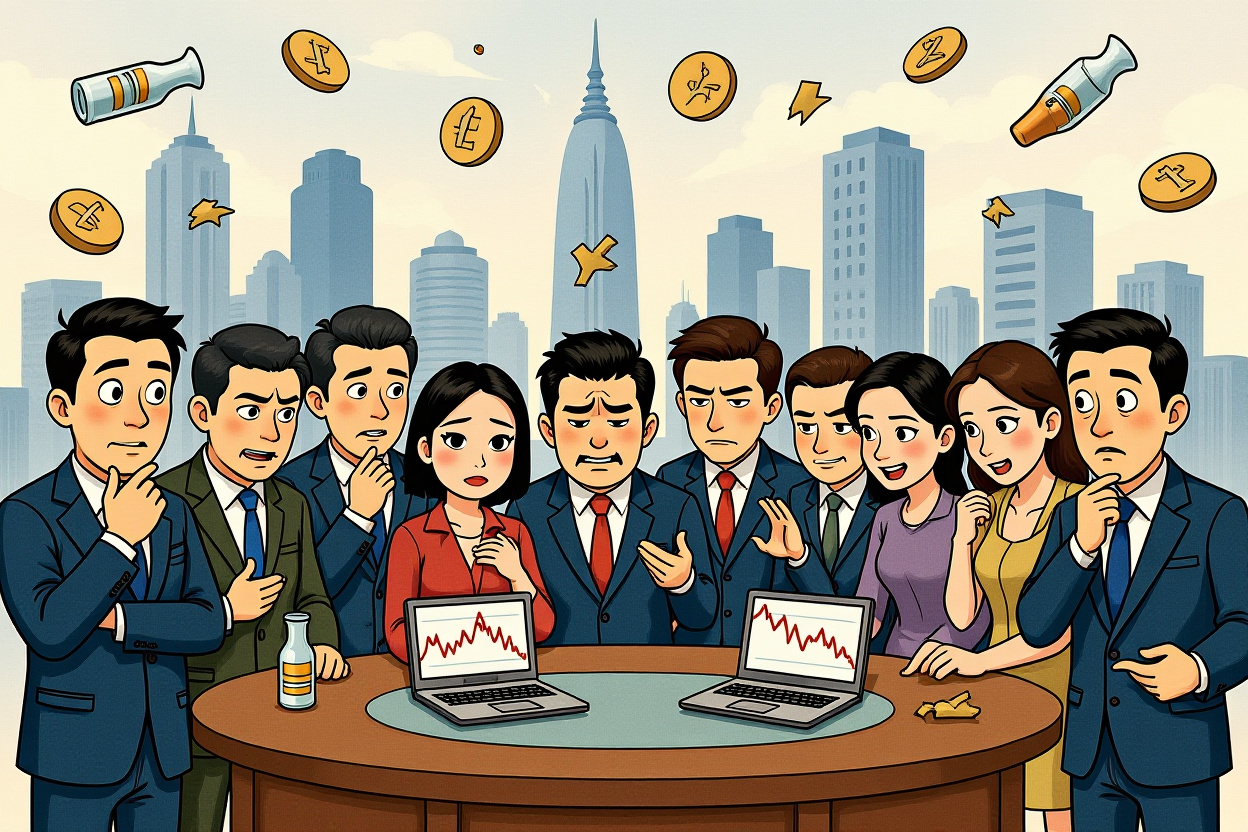The Ice Cream Price Vaccine Crisis During the summer of 2025, at an industry conference break, Liu Yongchao (刘永超), founder of vaccine education platform ‘Vaccine Circle,’ gathered with sales directors from several leading vaccine companies. The mood was somber. ‘I’ve been in this industry for over a decade, but why does it feel like the vaccine sector is getting cold?’ one sales director voiced what many were feeling. This gathering captured the growing anxiety within China’s once-booming vaccine industry. By August 2025, the numbers confirmed their fears. Multiple vaccine companies reported their worst mid-year financial results in history. Industry giants Zhifei Biological (300122.SZ) and Wantai Biological (603392.SH) both recorded their first half-year losses since going public, with net profits plummeting by 127% and 155% respectively. Among 17 publicly traded vaccine companies, only 6 managed to stay profitable, with the highest earner, Chengda Biological (688739.SH), reporting just 122 million yuan in profit. The broader picture was equally bleak. During the first half of 2025, China’s vaccine industry saw overall vaccine revenue drop by 60% year-over-year, while net profits collapsed by 113%. The five largest vaccine companies by market capitalization—Wantai Biological, Zhifei Biological, CanSino Biologics (688185.SH), Kangtai Biological (300601.SZ), and Walvax Biological (300142.SZ)—all struggled, with only CanSino reporting profit growth thanks to its exclusive quadrivalent meningococcal conjugate vaccine. Price Wars Reach Absurd Levels ‘Influenza vaccines have dropped to Mixue Bingcheng prices—as low as 5.5 yuan per dose,’ remarked a veteran vaccine industry insider, referencing China’s popular budget ice cream chain. The comparison wasn’t hyperbolic. In early September 2025, Beijing’s government procurement portal announced winning bids for influenza vaccines, with Shanghai Biological’s trivalent flu vaccine securing the contract at just 5.5 yuan per dose, setting a new record low for publicly funded vaccines. The price erosion has been dramatic and relentless. In September 2024, Shanghai Biological had broken the 10-yuan barrier for the first time with a 9.5-yuan winning bid in Zhejiang province. By 2025, the competition intensified further. In May, Fosun Yamirken dropped prices to 8 yuan per dose. By June, both Shanghai Biological and Changchun Biological pushed prices down to 6 yuan. The price war extended beyond influenza vaccines to nearly every major vaccine category: – HPV vaccines: Wantai Biological’s new nonavalent HPV vaccine entered the market at 499 yuan per dose, with a full three-dose course under 1,500 yuan – Zhifei Biological responded by effectively cutting prices of its imported nonavalent HPV vaccine from 1,300 to 900 yuan per dose through ‘buy one get one free’ promotions – In the bivalent HPV market, prices collapsed from 246 yuan per dose in 2022 to just 27.5 yuan in 2025 – Shingles vaccines: Zhifei Biological’s imported shingles vaccine dropped from 3,260 yuan for two doses to 1,652 yuan through similar promotional activities These drastic price cuts have devastated company financials. Wantai Biological, which relies heavily on bivalent HPV vaccines, reported revenue of 844 million yuan (down 38%) and a net loss of 144 million yuan (down 155%) in the first half of 2025—its first loss since going public. Walvax Biological also saw significant declines with revenue falling 19% to 1.154 billion yuan and profits dropping 75% to 43 million yuan. The Vaccine Hesitancy Challenge While price wars explain part of the industry’s troubles, they don’t tell the whole story. In its mid-year report, Zhifei Biological mentioned ‘vaccine hesitancy’ eight times while explaining its 73% revenue decline and 597 million yuan net loss. The company’s experience reflects a broader societal challenge that has intensified in recent years. A public health official explained the situation: ‘Vaccine hesitancy has become quite serious recently. Many residents don’t trust vaccines, and the slightest rumor makes them question their effectiveness.’ On the day he spoke with reporters, he had already fielded two queries questioning HPV vaccine efficacy. Vaccine hesitancy refers to delayed acceptance or refusal of vaccination despite availability. In China, vaccines are divided into two categories: Category 1 vaccines are government-procured and free to citizens (such as hepatitis B and polio vaccines), while Category 2 vaccines are voluntary and paid out-of-pocket (including rabies, influenza, and HPV vaccines). The hesitancy problem primarily affects Category 2 vaccines, particularly those perceived as optional rather than essential: – Influenza vaccines face significant hesitancy due to variable effectiveness against evolving strains – HPV and shingles vaccines struggle against misconceptions and low perceived urgency – Adult vaccines generally suffer from low coverage compared to childhood immunization programs Data from the Chinese Center for Disease Control shows concerning vaccination rates: between 2020-2023, China’s average influenza vaccination rate remained below 4%, with children around 12% and seniors under 5%. This contrasts sharply with approximately 50% vaccination rates in developed countries. Multiple factors contribute to this hesitancy according to industry experts: – Dissatisfaction with COVID-19 vaccination experiences during the pandemic – Skepticism about different vaccine technologies (mRNA vs. inactivated vaccines) – Widespread circulation of misinformation through social media and messaging platforms – Lack of risk awareness among adults regarding preventable diseases Structural Challenges in Adult Vaccination Unlike childhood vaccination programs with high coverage and public awareness, China’s adult vaccination system remains underdeveloped. In recent years, several provinces have experimented with vaccine prescription pilots, allowing clinicians to prescribe vaccines to eligible patients. However, implementation has faced significant challenges. Liu Yongchao compares adult vaccination to insurance: ‘Most people lack risk awareness. Compared to prevention, they prefer treatment after problems occur.’ Changing this mindset requires starting science education early, ideally during compulsory education years. Public health officials report practical difficulties in promoting adult vaccination. Many primary care doctors and nurses lack awareness about vaccines and show little enthusiasm for prescribing them. Without performance incentives for healthcare providers, vaccine prescription initiatives struggle to gain traction. ‘Without combining vaccine prescriptions, service accessibility, and information dissemination, we cannot truly drive market growth,’ noted one industry insider. The prescription system operates through recommendation rather than mandate, limiting its effectiveness without complementary measures. Industry Consolidation and Long Winter Ahead The COVID-19 pandemic created both opportunities and challenges for the vaccine industry. While it raised public awareness about vaccines and expanded the overall market, it also attracted excessive competition as companies rushed to develop COVID vaccines and expand production capacity. Zhifei Biological’s experience illustrates the changing market dynamics. After saturating the high-demand population for HPV vaccines, the company now faces the more challenging task of reaching low-demand or no-demand populations plus newly eligible cohorts each year. Meanwhile, it must compete with Wantai Biological and Walvax Biological in the bivalent HPV market while facing new competition from Wantai’s nonavalent HPV vaccine. The company’s mid-year report highlighted several structural issues: ‘Vaccine products in key categories face increasing homogenization, multiple segments experience fierce competition, products in clinical and registration stages continue to grow, supply continues to expand, and industry involution becomes increasingly significant.’ Liu Yongchao offers a vivid analogy: ‘The vaccine market is like a shrinking iron ball. Reduced purchasing power has wrapped it in ice, while homogeneous competition keeps adding more content inside the ball.’ CITIC Securities research notes continued pressure on vaccine sales and intensifying competition for certain products. The first half of 2025 showed declining performance across the vaccine sector primarily due to changed consumer demand from macroeconomic conditions and fierce competition for products like bivalent HPV vaccines, PCV13, and Vero cell rabies vaccines. Vaccine expert Tao Li’na (陶黎纳) analyzes the situation bluntly: ‘The competition is too brutal. I believe China only needs 3-4 suppliers for each vaccine type, but currently companies are crowding in with largely similar products, forcing price wars.’ Tao describes the current situation as the vaccine industry’s ‘deep freeze moment’ and believes China needs significant consolidation, with smaller companies being acquired or merging to form larger enterprises with comprehensive product lines. He also advocates lifting the default ban on vaccine advertising, though acknowledges that public acceptance won’t improve overnight. Based on current trends, Tao predicts the industry winter will last at least 5-10 years. Liu Yongchao shares this pessimistic outlook: ‘Birth rates are unlikely to rise short-term, adult vaccine awareness is difficult to change, and government procurement prices will always remain very low.’ Another industry insider concludes: ‘The vaccine industry is in the depths of winter, and this winter will be long.’ They believe fierce competition will inevitably lead to mergers, acquisitions, and technology transfers, with some companies failing entirely. Only when vaccine awareness improves and systems mature—particularly for adult vaccination—will the market expand sufficiently to support industry growth and innovation. Path Forward for China’s Vaccine Industry The current crisis presents both challenges and opportunities for China’s vaccine industry. While the short-term outlook appears difficult, the situation may force necessary structural changes that strengthen the sector long-term. Companies that survive the current shakeout will likely emerge leaner and more focused. The price pressure may drive innovation as companies seek differentiated products rather than competing in overcrowded generic vaccine categories. The government’s September 2025 announcement incorporating HPV vaccines into the national immunization program—while initially likely limited to domestic bivalent vaccines—represents a step toward broader vaccine coverage. However, significant challenges remain. Changing public perception requires coordinated efforts between government, healthcare providers, and vaccine companies. Improving physician education about adult vaccination, creating appropriate incentive structures, and combating misinformation are all essential components of rebuilding vaccine confidence. International expansion represents another potential growth avenue. Chinese vaccine companies have increasingly sought WHO prequalification and other international approvals that would allow them to export vaccines globally. Companies like CanSino Biologics have demonstrated that innovative products can succeed even in difficult market conditions. For investors and industry observers, the coming years will likely see increased merger and acquisition activity as stronger companies acquire valuable assets from struggling competitors. Regulatory changes, particularly regarding vaccine promotion and reimbursement policies, could significantly impact industry dynamics. Despite the current challenges, vaccines remain essential tools for public health. The fundamental demand for protection against infectious diseases hasn’t disappeared—it simply awaits companies that can navigate the current market transformation and deliver value to both healthcare systems and patients. Stay informed about pharmaceutical industry trends by subscribing to our business newsletter, and share this analysis with colleagues who need to understand China’s evolving vaccine market landscape.
China’s Vaccine Industry Crisis: Price Wars and Plummeting Profits Create Perfect Storm




